![]()
Solved Mystery Photos
![]()
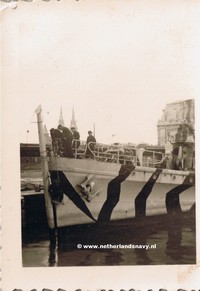 |
A German minesweeper in port during World War II. It appears to be one of the captured ships of the Van Amstel-class: M.551 (ex-Pieter Florisz), M.552 (ex-Willem van Ewijck) and M.553 (ex-Abraham van der Hulst). Can anyone identify the location where the photograph was taken? January 29, 2011: Reply by Daniel Zedanca: "...judging by the two church towers in the background, I think the photo was taken in Amsterdam. The two church towers in question or part of the Krijtberg of Sint-Franciscus Xaverius church, located at the "Singel". October 31, 2015: Reply by Nick Blomme: "...I think the photo was taken in the port of Ostende (Belgium), behind the train station. on the far right you can see the roof of the train station. In the distance, you can see the pointy tower tops of the Saint-Petrus-and-Paulus church. And left of the church, you can seen the stubby tower top of the Saint-Pieter tower (known amongst the people as "de Peperbusse" (the Pepper pot). |
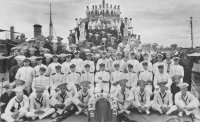 |
Crew photo of the destroyer Van Ghent in the 1930s (Collection Tiest Markies). Can anyone say when and where? The destroyer De Ruyter was rechristened Van Ghent on October 1, 1934 so the photo was at least taken after that date. January, 2008: Replies to the thread on the dutchsubmarines.com forum (read the thread here) make it likely the officer in the centre is Lieutenant-Commander J.M.L.I. Chömpff. He commanded the Van Ghent between April 6, 1939 and December 23, 1940. He was eventually killed in action on board the destroyer Piet Hein during the Battle of Badung Strait. Another indication for this dating are the fire control clocks on either side of the bridge. These were installed shortly before, or in 1940. Special thanks to Leon Homburg and Rob Harmse for their assistance. |
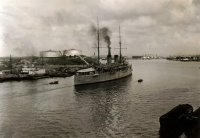 |
A photo of the Dutch armoured cruiser Gelderland entering port, probably in the Dutch West Indies. Can anyone identify which port? December, 2004: Reply by Jan Klootwijk: "...The port is Willemstad on Cura�ao. Coming from the sea, you enter the St. Anna Bay with Willemstad on both sides, towards the "Schottegat" behind the oil tanks..." |
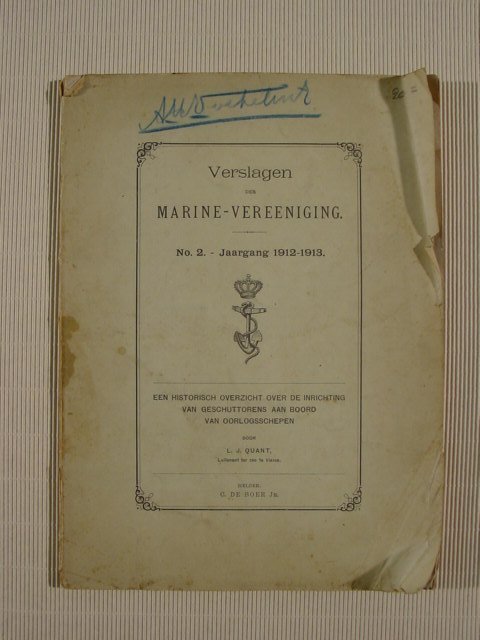 |
I bought this periodical on an auction site, and I was wondering if anyone knows more about the history of it. It's called Verslagen der Marine-Vereeniging. My issue is No.2 of 1912/1913, and it's a transcription of a presentation by Lt. Cdr. L.J. Quant about guns, ammo shafts etc. on warships. It's 114 pages thick, softcover, with many photos. Any information about the history of the magazine will be much appreciated. August 11, 2004: The answer to this question comes from "Honderd Jaargangen Marineblad". The Marine Vereeniging was an organization founded in 1883 with the intent to spread knowledge about maritime and military issues. Primarily, its members were naval officers. Six times each year, a meeting was held, and particulars of the subject covered in the meeting were also recorded in the form of a booklet. Later, these minutes became part of the Marineblad, a magazine with articles etc. about maritime matters. The seperate publication of the meetings ceased just before World War I. Marineblad itself was originally published as an addition to the "Verslagen der Marine Vereeniging". |
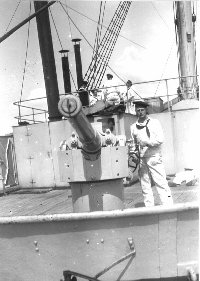 |
Photo sent to me by Chris van der Vliet. The man on the photo was his uncle, and he would like to know on which ship and when this picture was taken. The gun in question looks like a 75-mm gun, widely used in the RNN on minelayers and minesweepers, and training ships. July 15, 2003: Paul Magermans sent a photo of the training ship Noord-Brabant, a sistership of Gelderland refitted for use as accommodation and training ship in 1920. Professional sailors were given their first training there. The deck configurations on the photo left and the Noord Brabant are identical. |
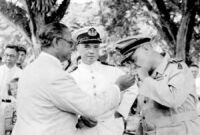 |
Commanders_small.jpg from Hank Tweedy This is a photo taken in 1948 on Sumatra. I would like to know who these men are. The navy captain in the center looks familiar, but I can't really place him. The men on the right apparently is a high ranking officer from the army (A KNIL-general ?), while the man on the left, the Indonesian, is apparently someone with status. March 19 2001: reply from Henry Klom: The general on the right is Lieutenant-General S.H. Spoor June 27 2001: reply from Bram Eweg: ".....I received information from the Landmacht, Sectie Militaire Geschiedenis in The Hague with help from Drs. J. van der Vos from the Nederlands Instituut voor Oorlogsdocumentatie. According to Sectie Militaire Geschiedenis de foto was made in 1948 during a visit from luitenant-gouverneur-generaal dr.H.J.van Mook to Medan, Noord-Sumatra. Although they did not have this particular foto they were able to identify the gentleman on the left as the (Indonesian) Wali-Negara of Sumatra Timoer: dr.T.Mansoer, and the (Dutch) Territorial Commander of North-Sumatra: Generaal-Majoor P. Scholten on the right. They were unable to identify the navy officer in the middle....." February 2003: According to Ad Mansoer, grandson of Dr. Mansoer, this photo was taken in March 1948, on occasion of the foundation of the Negara Sumatera Timoer. He has in his possession several other photos with these persons as well. His research revealed that the naval officer in question was Captain J.C. d'Engelbronner, a 1918 graduate of the naval academy. September 2004: Reply by Dirk d'Engelbronner: Mr. d'Engelbronner, grandson of the naval office, confirms the person in the photo is indeed his grandfather. |
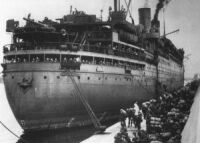 |
Troopship.jpg Allied troopship disembarking British troops in Algiers after the landings. I know it's a long shot, but I'm really curious which liner this is. Scanned from "The World at War", Navy Section, by Colin McIntyre November 23 2000 A reply from Chris: ".....This is just an off-the-west wall guess, but looking at the photo the liner in question compares most to the 4 Canadian Pacific 'Duchess' class ships. If you consult "Great Passenger Ships of the World, Volume # 3 1924-1935," on pages 102, 103, 104 & 105, all 4 of the ships have very similar characteristics to the one shown in your mystery photo and all did stints as troop ships, 2 being sunk in action - Duchess of Atholl off Ascensions, SS Duchess of Bedford also used as a troop transport and re-named SS Empress of India and later Empress of France after the war, the SS Duchess of Richmond (renamed Empress of Canada in 1947), and SS Duchess of York which was bombed in 1943 by German aircraft and finally sunk by convoy escorts. All four ships displaced some 20,000 tons, were 601 feet in length with geared turbines for an 18 knot service speed, 19 knots maximum. In peacetime they carried some 1,570 passengers and 510 crewmen. The contour stern and single anchor, I believe, are also features to be found on the Duchess class....." October 17 2001 Reply from Mr. Roger Jordan (via Warsailors.com forum): "....Cannot positively identify the vessel, but can tell you that it is definitely a Canadian Pacific Duchess, and it is not Duchess of Atholl, which as you know leaves three possibilities....." September 22 2002 Reply from Maureen Venzi (via Mercantile Marine Forum): John Slader has the same photo in his book "The Fourth Service: Merchantmen at War 1939-45" (London: Robert Hale, 1994) in the section between p 182 and 193. The caption for it reads: "Duchess of Richmond. Operation Torch, seen at Algiers disembarking troops and baggage, 14 November 1942...". . In his "Picture Credit" paragraph on p 9, John Slader lists the Imperial War Museum as the source of the photo. |
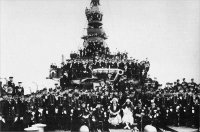 |
Java_comp.jpg from Robert de Rooij This photo was sent to me by Robert de Rooij, and it shows the crew of the cruiser Java during a ceremony, apparently. In the center, several members of the Dutch royal family can be seen. I'd be interested to know during which occasion this photo was taken. (additional note: the superstructure of the cruiser seems to suggest a picture from the late 1920s) January 27 2002 Reply from Admiral Gurita: In the middle are Queen Wilhelmina and Princess Juliana. The Java left for the Netherlands East Indies on October 14 1925, and spent most of her career there. Only in 1937/1938 did she return to Holland for an overhaul (arrival May 23 1937, after the Fleet revue at Spithad and with Princess Juliana and Prince Bernhard on board, who had visitied Britain. Left May 4 1938). As far as I know, Queen Wilhelmina never visited the Netherlands East Indies, so the photo must have been taken in Holland. The most probable occasion is September 24 1925. In "Hr. Ms. kruisers Java and Sumatra" by J. Anten (publisher Asia Maior), there is a photo published on page 62 with the Queen on the side-rope and the welcoming officers. The Princess is not visible, but she was present according to the biline. The Princess looks like a teenager on your photo, and I can't see Prince Bernhard. August 9, 2004: Reply by the webmaster: I have found a newspaper clipping which confirms what is said above. The clipping is dated 1925, and shows the same photo. The biline identifies the people sitting as (from left to right): Commander M.J. Verloop (aide-de-camp of Queen Wilhelmina?), Captain L.J. Quant (commanding officer of Java), Queen Wilhelmina, Princess Juliana, Vice-Admiral C. Fock (Commanding Officer of Den Helder naval base), and Acting Vice-Admiral F. Bauduin (retired, aide-de-camp "in special service" of Queen Wilhelmina) . Standing behind Captain Quant and Queen Wilhelmina is (then) Lieutenant-Commander J.Th. Furstner, executive officer. The photo was taken in Amsterdam. |
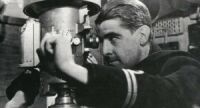 |
Subcapit.jpg A Dutch submarinecaptain looking through his periscope, probably a pose. The man is a Lieutenant (Luitenant-ter-zee der 2de klasse), and I would really like to know who this is. January 31 2002: Answer from Joep Frijdal: The officer in the photo is Lt. Pieter Bussemaker, born April 27 1917 on Java island. This photo was made for recruitment purposes. |
![]()
| Back | Home |